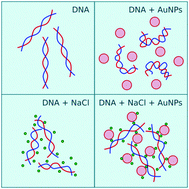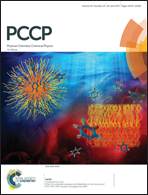Understanding and improving aggregated gold nanoparticle/dsDNA interactions by molecular spectroscopy and deconvolution methods†
Abstract
It is well known that single-stranded DNA (ssDNA) is easily able to adsorb on citrate-capped, non-functionalized gold nanoparticles (AuNPs). However, the affinity of double-stranded DNA (dsDNA) for them is much more limited. The present work demonstrates that long dsDNA suffers from a bending conformational change when anionic nanoparticles are present in solution. A striking decrease in the persistence length of the double helix in the absence of salt is observed through dynamic light scattering (DLS), viscometric, and atomic force microscopy (AFM) methods. Long dsDNA is therefore shown to be able to interact with anionic gold nanoparticles. To date, only ssDNA detection has been described by making use of interparticle cross-linking aggregation mechanisms; however, the data shown in this work allow for the development of new methods for detecting dsDNA in solution by using aggregated AuNPs as a starting point. The aggregation state is induced by the controlled addition of an inert electrolyte. A deconvolution procedure of the experimental plasmon shows how individual bands corresponding to aggregated nanoclusters diminish as the DNA concentration increases in the presence of 0.075 M NaCl.



 Please wait while we load your content...
Please wait while we load your content...